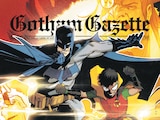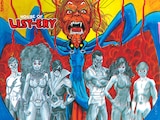
Gotham tells the tale of Jim Gordon, the Gotham City Police Department’s straight-and-narrow new detective, and Harvey Bullock, his world-weary older partner. It’s also the story of Fish Mooney and Oswald Cobblepot, a Gotham crime lord and her less-than-loyal minion. And it’s the story of Bruce Wayne, the boy who was orphaned when his parents were murdered by a mysterious gunman. Gotham features a large cast of characters with rich, complex back stories that skirt both sides of the law. But there’s one key character who speaks no lines, yet can be seen in every shot and scene—the City of Gotham itself.
The Gotham of FOX’s upcoming Batman prequel is unlike any that fans have seen before. Gone are the Gothic spires of Tim Burton’s take on the city or the clean, cutting edge modernity of Christopher Nolan’s Dark Knight films. Gotham gives us a city that feels both timeless and new, with a roughness that’s just under the surface, primed to explode.
“Everyone has a vision of Gotham in their mind,” says Gotham Executive Producer Bruno Heller. “So you really have to create a three-dimensional world that is both believable, but a notch above reality. That has that fantastic element.”

Part of that element seems to be blurring the line regarding the show’s time period. While there are modern touches, such as cell phones, many of the vehicles on the show seem to be classic models. Fish Mooney’s nightclub is reminiscent of an old burlesque hall, with a touch of 21st Century sexiness. Then there are the aspects that are pure fantasy, such as the GCPD blimps. They don’t appear in the pilot episode, but they’re visible in many of the show’s promotional images, suggesting that at the very least, they’re there in spirit.
Like with many Bat-projects, Gotham City does feel reminiscent of New York City, but not the cleaned up, tourist-driven version of today. Rather, Gotham takes much of its inspiration from the New York of the 1970s, where you were just as likely to lose your cash in a mugging as in a Times Square souvenir shop.
“Both me and Dan Cannon, the director, had kind of seminal moments in New York in the ‘70s when it was a really gnarly, dark, but very sexy and attractive, charismatic place,” explains Heller. “So that’s the seed of the city. That old New York.”

Much like New York, Gotham is massive and far reaching. From the glamorous penthouses of the wealthy, to the grime riddled alleys of downtown, to the working-class grit of the docks, it’s a city of communities and of microcosms. It’s an urban playground where secrets and danger can lurk around any corner, where corruption runs rampant and where blood runs in the gutters. It’s a place designed to keep you on your toes and give the characters of the show the best setting possible against which to shine.
“Danny and his crew did such an amazing job creating a believable, but fantastic world,” Heller says. “It allows the actors inside that city to be a notch up. It’s both real, but slightly surreal, and that means you have a broad and powerful canvas to work off of.”
It’s also a city that could believably house all of the many people, groups and places that have helped to form Batman’s 75-year history. It’s not hard to imagine that the young men and women who will over time become the Joker, Two-Face, Scarecrow, Harley Quinn, Mr. Freeze and the other not-yet-introduced villains could all be fatefully residing in parts of the city that we simply haven’t yet seen. Gotham, both the city and the show, seem primed to surprise us. But no matter where the plot veers and which characters take the spotlight in the future, we can expect Gotham City to continue to remain a key role.
As Heller points out, “It’s not an accident we call Gotham.”
Gotham airs Mondays at 8 p.m. (7 p.m. CST) on FOX.















